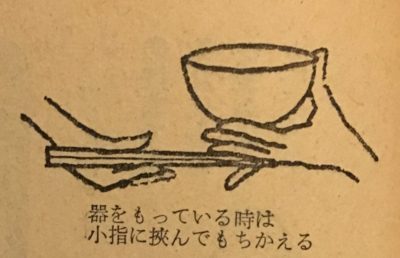Hello! I’m just back from visiting Mexico for the first time. I haven’t used my Spanish for 15 years, so I was pleasantly surprised with how much I was able to understand. Need to work on the speaking part. I was throwing out tons of けどs and ああ、そうs in my effort to make conversation.
While I was away, I had another Bilingual article in The Japan Times. I took a look at a 1965 エチケット事典 (Etiquette Encyclopedia): “A Japanese guide to dealing with gentleman callers and unruly dogs.”
It’s a pretty amazing text, and I look forward to reading through it more thoroughly. I wanted to share a couple of fun sections here. Under food, the author provides a list of 食べにくい一品料理 (tabenikui ippin ryōri, Difficult-to-eat items), one of which is 生かき (namakaki, raw oysters). Here are the instructions for eating them:
必ずレモンがそえてあります。これを絞りかけますが、レモンを絞る時はいつの場合でも、汁がまわりに飛ばないように左手でおおうのがエチケットです。レモン汁をかけたら左手で貝の殻をおさえ、かき用のフォークですくって一口に頂きます。
They are always accompanied with lemon. You squeeze this on top, but when you squeeze the lemon, it is always polite to cover it with your left hand so the juice doesn’t spray the surroundings. After adding the lemon juice, hold the shell of the oyster with your left hand, scoop out the oyster with an oyster fork, and eat it in one bite.
A couple of cool linguistic things to note here:
The first is the way エチケット gets used here to end the second sentence. Very interesting. A more literal translation would be “it is etiquette to cover it with your left hand.” I guess there’s a way to get closer to the Japanese than my translation. Something like “etiquette calls for…” or maybe “the etiquette is…”
Second, 貝の殻 is pretty interesting in that both characters can mean shell. 貝 seems to be referring to the meat of the oyster in this case, and it can mean shellfish more broadly whereas 殻 only refers to the shell or other kinds of outer coverings.
And if the oyster instructions didn’t convince you that this book is precise and prescriptive, check out some of the guides to 箸を上手に使うマナー (hashi o jōzu ni tsukau manā, Manners for using chopsticks well). In addition to the typical instructions, they provide this photograph for the section 器を持ったまま取る時 (ki o motta mama toru toki, taking them while holding a dish):

And the instructions:
左手で器を持ち右手で上から箸を取り、左手の薬指か小指で箸をはさんで右手を持ちかえます。逆に箸を持ったまま、お茶碗やお椀を取る時は、箸先を手前にして右手の掌と薬指、小指の間に挟み持ち、親指と人さし指と中指を使って取り上げます。
Hold the dish with your left hand and take the chopsticks from above with your right. Slip the chopsticks between your ring finger or pinky and hold the dish with your right hand. Conversely, if you’re picking up a teacup or bowl while holding chopsticks, hold the chopsticks between your right palm and ring finger or pinky with the tips facing out and take the teacup or bowl with your thumb, index finger, and middle finger.
Am I the only person who didn’t already know of this technique? The second half of the instructions seem to make more sense to me than the first, which seem a little…precious? Or maybe I’m mistranslating based solely on the image from the text. I’d be curious to hear from readers on this one.
And don’t forget the cool finger vocab listed in the paragraph above!
This is a great text. I might have to buy a more modern version just to see the kind of things that are listed. And I can see myself coming back to this old one for future blog posts.


